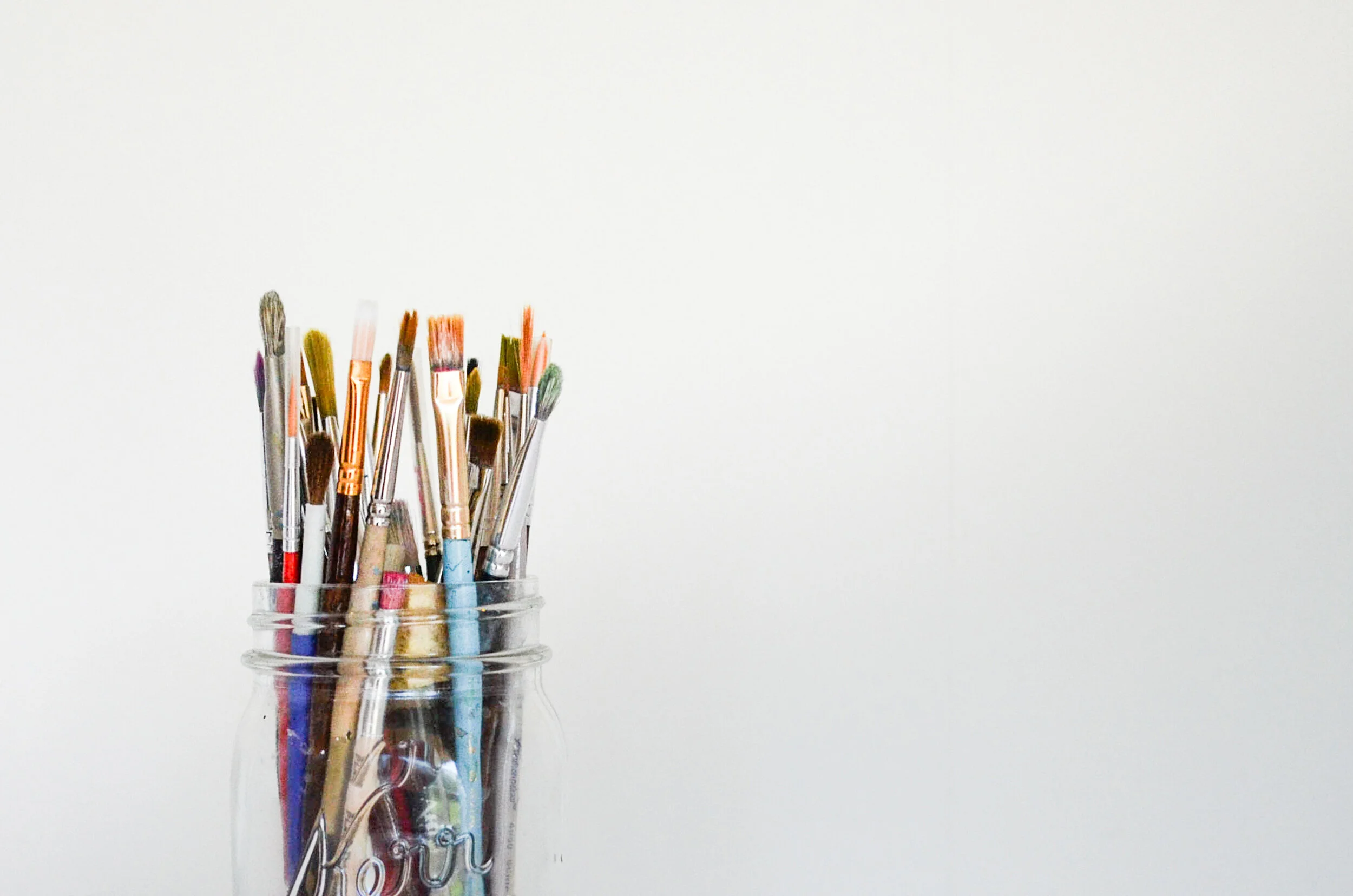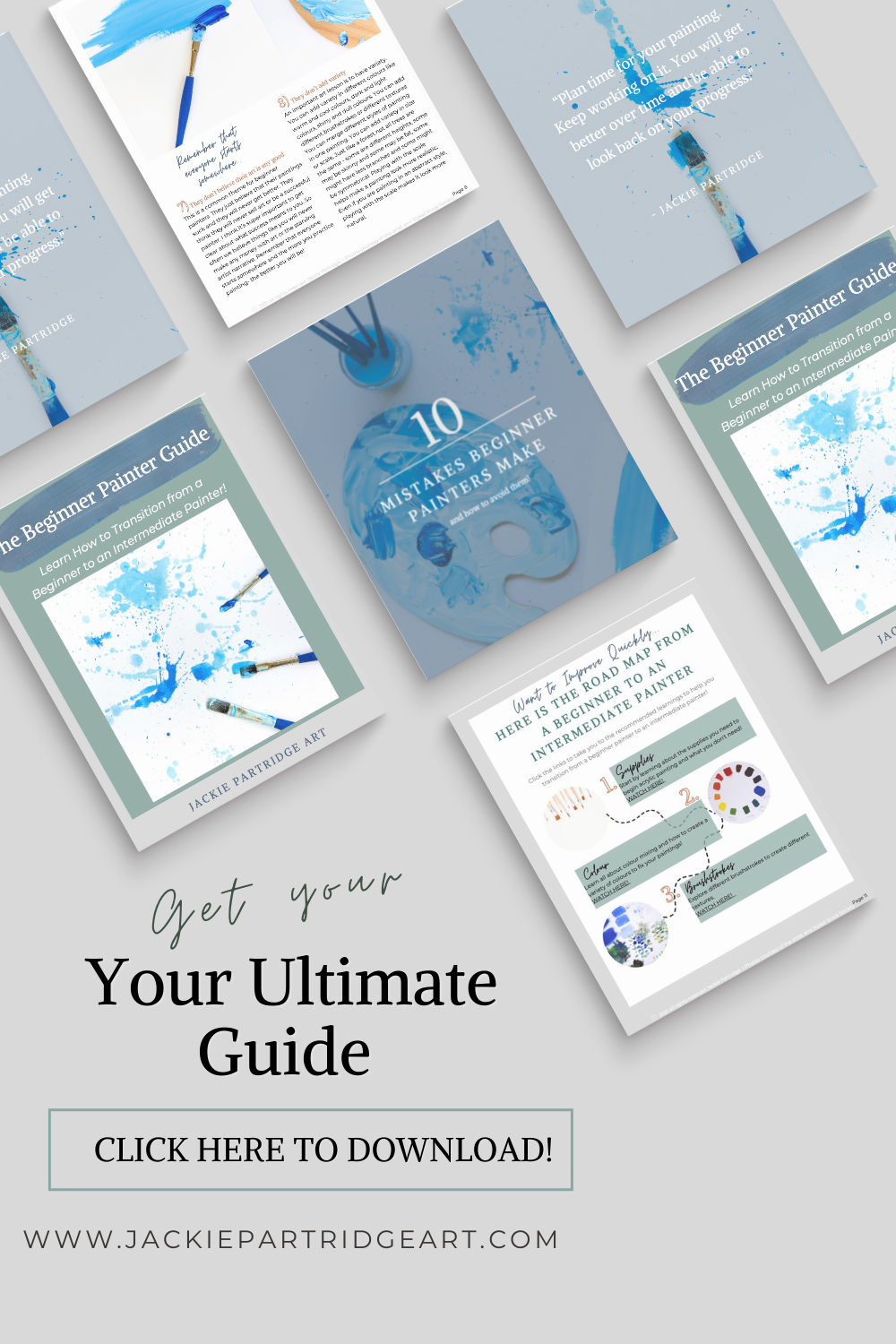Getting started with acrylic painting can be overwhelming. It can be challenging when you are new to acrylics and not knowing what supplies you need. Learn from me, Jackie Partridge - I am an acrylic painter with my Master of Fine Arts. I want to help you get better at acrylic painting and feel more confident as a painter!
Buying art supplies can be overwhelming -there are A LOT of options! I really encourage you to use what you have and to plan what you need before buying. Start with the basics then add to your art materials!
I have outlined some basic supplies to get you started with acrylic painting- if you have questions feel free to ask them in the comments! If you prefer to see a video of me explaining the art supplies you can check it out here!
Grab my FREE painting guide for beginner painters- providing you with lots of tips to improve your painting!
Get it here!
How to Get Better at Painting
How to Save Money on Art Supplies
Use supplies you may already own or try asking friends and family. They might have extra, or old supplies they are looking to get rid of
Take your time to do research before purchasing online or going to an art supply store. Read reviews and compare prices. Take your time to invest
Remember you don’t need everything - you can slowly add to your collection over time
Look for options to buy in bulk (they sell canvases in packs or pads of watercolour paper - buy in bulk for items you will use lots of (like white paint)
Getting Started with Acrylics - the Brushes
Brushes come in natural hair or synthetic. The synthetic brushes are easier to clean and the brushes are less expensive- these are what I recommend for beginner painters! Brushes also come in long or short handles - it is really up to your preference and what feels best to hold.
Flat brush - have a flat edge to the bristles - I recommend getting a brush that is about 1-2 inches wide. These brushes are good for painting larger areas like a background or sky.
Round brush- these brushes come to a point. I recommend getting a small one for details and more of a medium brush like a size 6 for covering more area. The smallest brush will be for painting details like outlines, fine lines or small dots and the medium one is better for other areas like tree branches.
Tips To Save Money on Brushes:
I encourage you to use the brushes you have and look at price points. Usually you can get a set of small detail brushes that have even more types than the basics I have suggested -it’s good to have back up brushes as smaller brushes won’t last as long because they have less bristles. An affordable brand I recommend for brushes is Artist Loft.
Getting Started with Acrylics -Paint
When buying brands of paint consider your budget. If you are just starting out I recommend getting a student grade paint versus artist quality. What’s the difference?
Student grade- cheaper price, still a good consistency, good pigments for the price you are paying, colours will fade over time (hanging a painting in a sunny room for a decade…) however you can apply a coating to help prevent the paint from fading.
Brands I recommend are: Liquitex -Basics, Rheotech, Amsterdam
Artist grade- paint is more expensive, paint is often thicker (less water in the consistency), the consistency is richer/smoother, the paint will not fade as much over time, the pigments are stronger, darker, deeper colours (there’s more real pigments in the paint which is why the price is higher)
Brands I recommend: Golden
Tips To Save Money on Paint:
If paint is too cheap - it might not be the best quality to use - you might need to add more paint/layers and it will probably not be as nice of a consistency to work with. If you are trying a new paint or different brand than what I list -try buying one paint tube from the brand and test it out - buy a smaller sample size and see if you like it. Make sure to do research and read product reviews or ask other artists.
In my videos I show you how to only use the primary colours and black and white paint.
With these basic colours you can mix everything you need: (these are the colours I recommend. You want to choose colours that are as close to the primary colours as possible). Sometimes brands will call them primary red etc. as long as it looks close to a real true primary red -that’s fine!
Cadmium Red
Cadmium Yellow
Cobalt Blue
Mars Black
Titanium White
Painting Surfaces
You can paint on a variety of surfaces including canvas, canvas board and watercolour paper.
Canvas- you can buy canvases in bulk packs for a lower price. They come already stretched on the wooden frame and primed in a white coating called Gesso. I recommend starting in a smaller size like 9”x12” or 11”x14.” You can buy them from an art supply store- you can get them from the dollar store but the quality won’t be as good.
Canvas board- Canvas board is cheaper than canvases and the boards are flat -if you are doing a lot of painting it will be easy to store them and stack them. Essentially they are the same canvas texture but on cardboard versus stretched over a wooden frame.
Watercolour Paper- if you are painting on a thick watercolour paper (close to 300 lb weighted paper) it will hold acrylics - it is fine to work on paper to save money and gain practice and confidence in your painting. Watercolour paper is one of the most affordable options! Make sure to tape your paper down using painter’s tape to keep the paper from curling. You can also flatten your paper after your painting has dried by placing a stack of heavy books on top!
Other Necessary Materials
A container for your water to clean your brushes (an old jar or cup will work) - this container will get dirty and stained over time
An old rag (old towel or T-shirt is fine) something that you will dab your brushes with to clean them. You can also use paper towel - but I find a rag is a more environmentally friendly and a FREE option
A palette - I bought mine several years ago and have been unable to find one similar to it. I use a reusable plastic palette. It’s long and has separate compartments to mix paint. It also has a lid to store the paint and keep it from drying out. Paint usually lasts about a week and half with the lid on. If you have a plastic palette without a lid any leftover paint will usually dry in a day. Using an old plastic container or old plastic lid would also be fine.
A tablecloth and old clothes- acrylic paints do stain so it’s important to protect the surface you are painting on as well as your clothes. Wear old clothes or an apron. I usually paint in a long lab coat that I bought at a thrift store for $10.
Palette Knife painting with a palette knife and paint palette.
Extras to Have
I really recommend an easel especially if you have back or neck problems/poor posture. When you are painting it is easy to get in the zone and often you don’t take breaks to stretch which can cause a lot of neck and back pain later on. Having an easel allows you not to be hunching over as much. You can purchase a floor easel that stands on the ground. These easels are adjustable so you can stand while painting or sitting on a stool/chair. You can also get a table top easel, they rest on a table and you can sit while painting. When buying an easel look for something that is not flimsy (some of the aluminum ones are). I find the wooden easels are usually good quality. I like to go to an art store like Curry’s or Michaels to buy easels to see the quality for myself unless there are lots of strong reviews online.
Extra paint - paint comes in a lot of colours and it can be overwhelming to choose. I suggest buying extra colours that you can’t mix like having a second blue or a second yellow or red. Having two different tones of these colours will allow you to mix a wider range of colours. Blues come in Cobalt, Ultramarine (these are two that I recommend) also other blues like Phthalo, Cerulean etc. Learn about colour mixing so you don’t need to buy each colour here!
Palette Knife- choose from a less expensive option of plastic or wood and metal palette knives. Palette knives are fun and easy to use and help add abstract texture to your paintings. Watch my popular video on choosing the right palette knife -here.
Watch helpful acrylic painting tutorials and check out my acrylic painting tips by clicking the button below!
There you have it! Your list of basic art supplies to get you started. If you have any questions please leave them in the comment section below. Have fun and Happy Painting!
For More Tips -join my mailing list where I send you an email every two weeks full of tips to keep you inspired and creative. You will also have access to discounts on future courses and exclusive video painting lessons every season! Click the button below to grab a FREE Guide of my 10 Tips to Help Make You a Better Acrylic Painter!
Related Articles:
Save money by mixing your own colours!
My favourite painting supplies!
Related Resources:
Mixing Green and Grey FREE resource
Stay connected with me on social media by clicking one of the icons below!







